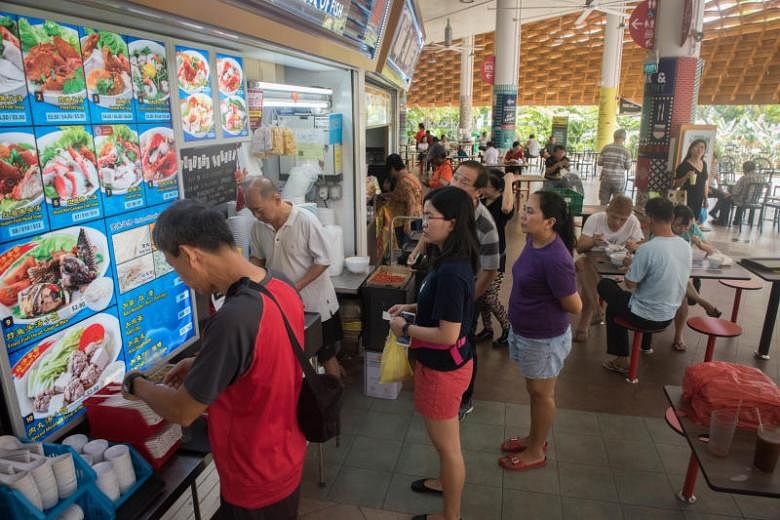SINGAPORE - The model under which seven new hawker centres are run by social enterprises is generally sound in spite of issues with its implementation, Environment and Water Resources Minister Masagos Zulkifli told Parliament on Monday (Nov 19).
His ministry has heard the feedback from Singaporeans, and will adjust the scheme to better serve patrons and look after hawkers' well-being, he added.
Mr Masagos and Senior Minister of State Amy Khor fielded 19 questions from MPs on these socially conscious enterprise hawker centres (SEHCs), which have come under public criticism for imposing unnecessary rules and an extra layer of costs on hawkers.
"Give the model time to adapt, adjust and optimise the outcomes we seek to achieve," he said, citing affordable yet good food, a decent living for local hawkers that is sustainable, and the need to preserve hawker centres.
Mr Masagos explained to members why the Government embarked on this model when it restarted building hawker centres in 2011, after a hiatus of almost 30 years, in response to widespread appeals from Singaporeans.
"We resumed building hawker centres to serve as a ballast to stabilise cooked food prices against the emerging dominance of coffee shops and foodcourts," he said.
However, he added that just by building new hawker centres, the Government cannot automatically expect them to be viable and sustainable. Some hawkers, for example, only work short hours. The median age of hawkers is about 60 years old and many successful hawkers say they hope their children will not follow in their footsteps.
Mr Masagos said: "We have to transform and find ways to make the hawker trade sustainable; or we may end up with hawker centres without hawkers."
To adapt to changing needs and circumstances, it was critical to find new operating models to sustain the hawker trade, he added.
"This is why we are trialling the SEHC model for our new hawker centres."
He explained that the SEHC operators bring new ideas and inject innovation that hawkers individually or the Government cannot. For example, they are able to curate food stalls for quality and variety. They can also bring in famous food recipes, and are better placed to run hawker incubation programmes to help sustain the hawker trade.
In addition, they innovate to improve footfall and enhance vibrancy of the centres through better marketing and place-making programmes, and not just leave it to chance, said the minister.
As the single operator of each hawker centre, with food and beverage and management competencies, these SEHC operators can help hawkers weather the competition from other F&B alternatives and adapt to technological disruptions, better than the hawkers can individually, he added.
"In time to come, the better SEHCs will develop capabilities to support and sustain the hawker trade that we will appreciate," he said.
While Mr Masagos was heartened by the recent public discussion on how existing NEA centres are run better than the SEHCs, he said: "It is not enough to keep doing things the same way. This is why we have to continue with the SEHC model."
He explained that on the whole, SEHCs have achieved good outcomes despite the short time they have started operations. For instance, food prices at SEHCs are affordable and comparable to existing centres, SEHC operators have curated food stalls for quality and variety ,and have also kept their centres open during breakfast, lunch and dinner hours.
Nonetheless, the SEHCs will take time to establish themselves, he added.
"The market mechanism is working, and Government should not intervene unnecessarily, in mandating low or no rental, which could otherwise affect fair competition."
Hawkers are entrepreneurs, after all, he pointed out.
"We want to reward successful hawkers to sustain the trade and preserve our beloved hawker heritage. It is natural to have some level of churn as better hawkers replace those who are less suited for the trade."
Market forces would lead to a fair distribution of hawker stalls, which ultimately benefits residents, he added.
"It is inappropriate for Government to subsidise a hawker on the basis that business is poor. This would be unfair to a better-performing hawker who thrives on healthy competition. It would also be unfair to other private-sector food shop operators located in close vicinity to the centres," he said.
The model must therefore ensure that rentals and costs are transparent and fair to hawkers, but cannot subsidise hawkers to the extent that it distorts the workings of the market, he added.
"As with any trials and experiments, we cannot always get it right the first time. We have heard the feedback, and will adjust the model to better serve Singaporeans. We will continue with the SEHC model, and improve it so as to serve patrons well and look after the well-being of our hawkers."


